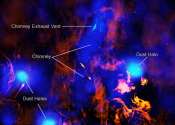Dark matter travelling through stars could produce potentially detectable shock waves
Dark matter, a hypothetical material that does not absorb, emit or reflect light, is thought to account for over 80 percent of the matter in the universe. While many studies have indirectly hinted at its existence, so far, ...








